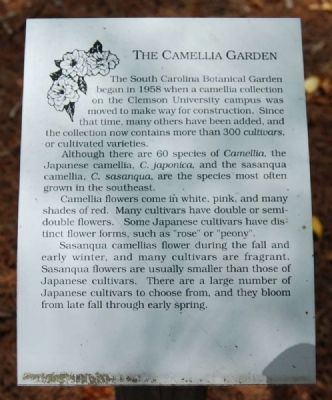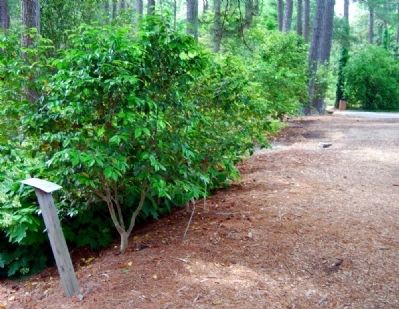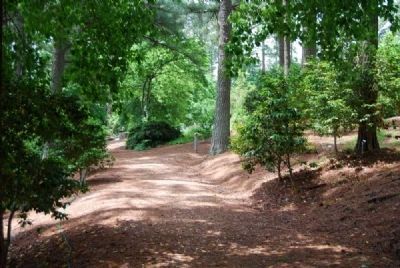Clemson in Pickens County, South Carolina — The American South (South Atlantic)
The Camellia Garden
The South Carolina Botanical Garden began in 1958 when a camellia collection on the Clemson University campus was moved to make way for construction. Since that time, many others have been added, and the collection now contains more than 300 cultivars, or cultivated varieties.
Although there are 60 species of Camellia, the Japanese camellias, C. japonica, and the sasanqua camellia, C. sasanqua, are the species most often grown in the southeast.
Camellia flowers came in white, pink, and many shades of red. Many cultivars have doubled or semi-double flowers. Some Japanese cultivars have distinct flower forms, such as "rose" or "peony".
Sasanqua camellias flower during the fall and early winter, and many cultivars are fragrant. Sasanqua flowers are usually smaller than those of Japanese cultivars. There are a large number of Japanese cultivars to choose from, and they bloom from late fall through early spring.
Topics. This historical marker is listed in this topic list: Horticulture & Forestry. A significant historical year for this entry is 1958.
Location. 34° 40.517′ N, 82° 49.283′ W. Marker is in Clemson, South Carolina, in Pickens County. Marker can be reached from Perimeter Road. Marker is located on the grounds of the South Carolina Botanical Garden. Touch for map. Marker is at or near this postal address: 150 Discovery Lane, Clemson SC 29634, United States of America. Touch for directions.
Other nearby markers. At least 10 other markers are within walking distance of this marker. Dr. Luther W. Baxter (within shouting distance of this marker); Log House (about 300 feet away, measured in a direct line); Hunt Cabin (about 300 feet away); Hosta Garden Donors (about 400 feet away); The Charles and Betty Cruickshank Hosta Garden (about 500 feet away); The Hayden Conference Center (about 600 feet away); The T.L. Senn Horticultural Gardens (about 600 feet away); Golden Tigers and Class of 1942 Cadet Life Garden (approx. 0.2 miles away); Heritage Gardens (approx. 0.2 miles away); Heritage Gardens Entrance (approx. 0.2 miles away). Touch for a list and map of all markers in Clemson.
Also see . . .
1. SC Botanical Garden. The South Carolina Botanical Garden is a diverse 295 acres of natural landscapes, display gardens, and miles of streams and nature trails. (Submitted on June 1, 2009, by Brian Scott of Anderson, South Carolina.)
2. South Carolina Botanical Garden. The South Carolina Botanical Garden (295 acres) is located in Clemson, South Carolina on the campus of Clemson University. (Submitted on June 1, 2009, by Brian Scott of Anderson, South Carolina.)
3. Camellia japonica. The Japanese Camellia (Camellia japonica) is one of the best known species of Camellia. (Submitted on June 1, 2009, by Brian Scott of Anderson, South Carolina.)
4. Camellia sasanqua. The Christmas Camellia (Camellia sasanqua) is a species of Camellia native to the evergreen coastal forests of southern Japan in Shikoku, Kyūshū and many other minor islands as far south as Okinawa. (Submitted on June 1, 2009, by Brian Scott of Anderson, South Carolina.)
Credits. This page was last revised on June 16, 2016. It was originally submitted on June 1, 2009, by Brian Scott of Anderson, South Carolina. This page has been viewed 1,073 times since then and 42 times this year. Photos: 1, 2. submitted on June 1, 2009, by Brian Scott of Anderson, South Carolina. 3. submitted on June 2, 2009, by Brian Scott of Anderson, South Carolina.


